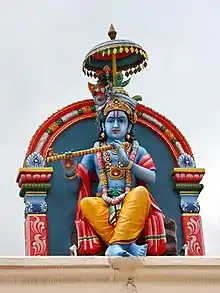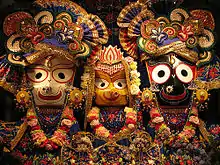Nityananda
Nityānanda (born in Ekachakra, Bengal Sultane, present day in Birbhum district of West Bengal 1474), also called Nitai, was a primary religious figure within the Gaudiya Vaishnava tradition of Bengal. Nitai was Chaitanya Mahaprabhu's friend and disciple. They are often mentioned together as Gaura-Nitai (Gaura, "golden one", referring to Chaitanya, Nitai being a shortened form of Nityānanda Rama) or Nimai-Nitai (Nimai being another name of Chaitanya).[1] Followers often refer to Nityānanda as "Sri Nityananda", "Prabhu Nityananda" or "Nityananda Rama".
Sri Nityananda Prabhu | |
|---|---|
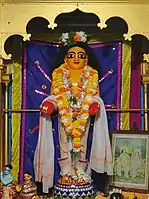 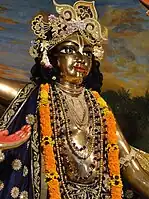 Left: Wooden Idol of Nityananda Prabhu, Nitai Bari, Nabadwip, Right: Archa-Vigraha of Śrī Nityānānda Prabhu, ISKCON Mayapur | |
| Personal | |
| Born | circa 1474 |
| Died | c. 1540 |
| Religion | Hinduism |
| Spouse | Jahnava and Vasudha |
| Parents |
|
| Known for | Expounded Gaudiya Vaishnavism, Bhakti yoga along with Śrī Kṛṣṇa Caitanya Mahaprabhu and Śrī Advaita Ācārya |
| Philosophy | Bhakti yoga, Achintya Bheda Abheda |
| Religious career | |
| Guru | Madhavendra Puri (mantra guru) |
| Associates | Śrī Advaita Ācārya, Śrī Kṛṣṇa Caitanya Mahaprabhu, Śrī Gadadhāra Pandita, Śrīvāsa Thakura, Haridasa Thakur and others |
| Part of a series on |
| Vaishnavism |
|---|
 |
| Part of a series on | |
| Hindu philosophy | |
|---|---|
 | |
| Orthodox | |
|
|
|
| Heterodox | |
|
|
|
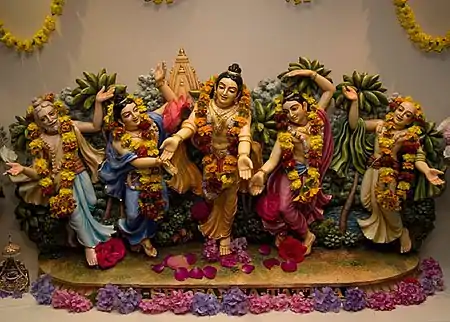
According to Gaudiya-Vaishnava tradition, Nityānanda is an incarnation of Balarama, with Chaitanya being his eternal brother and friend, Krishna.[2] He is considered the "most merciful" incarnation of the Supreme Personality of Godhead[3] (a term popularised by A.C. Bhaktivedanta Swami).
Bhaktisiddhanta Sarasvati writes: "Nityananda is the Primary Manifestive Constituent of the Divinity. Nityananda alone possesses the distinctive function of the guru. In Nityananda, the function is embodied. Nityananda is the Primary Manifestive Constituent of the Divinity. Nityananda alone possesses the distinctive function of the guru. In Nityananda, the function is embodied. Nityananda is the servant-God."[4]
Life
Nityānanda was born to a religious Bengali Brahmin, known as Pandit Hadai, and his wife, Padmavati,[5] in Ekachakra[6] around the year 1474. His devotion and great talent for singing Vaishnava hymns (bhajan) were apparent from a very early age. In his youth, he generally played the part of Lakshman, Rama's younger brother, in dramatic re-enactments of Lord Rama's pastimes, along with the other boys of Ekachakra.
At the age of thirteen, Nitai left home with a travelling renunciate (sannyasi) known as Lakshmipati Tirtha. Nityānanda's father, Hadai Pandit, offered Lakshmipati anything he wished as a gift, who replied that he was in need of someone to assist him in his travels to the holy places, and that Nityānanda would be perfect for the job. As he had given his word, Hadai agreed, and Nitai joined him in his travels. Apart from Lakshmipati, who at some point initiated him, Nityānanda was also associated with Lakshmipati Tirtha's other disciples: Madhavendra Puri, Advaita Acharya, and Ishvara Puri, the spiritual master of Chaitanya Mahaprabhu.
He died sometime between the years 1540 and 1544.[7]
Marriage and descendants
%252C_Mata_Janhava_(right).jpg.webp)
Nitai married two daughters of Suryadasa Sarakhela: Vasudha and Jahnava Devi with the help of Uddharan Dutta Thakura of Saptogram. After marriage, he settled in Khardaha, 24 Parganas, West Bengal. He had a son, Virachandra Goswami or Virabhadra who was later initiated to Vaishnava rites by his co-mother Mata Jahnava Devi, and a daughter, Ganga, by his first wife, Vasudha.[8]
Legacy
Chaitanya and Nityānanda's deeds have deep religious and cultural implications in Bengal. They are credited with the revival of Hinduism in Eastern India, society plagued mainly by the caste system, which they denounced. Much of Vaishnava literature, regarded as one of the finest literary heritages of medieval Bengal, came from them or their disciples.
References
- Dimock, E.C. (1958). "The Place of Gauracandrika in Bengali Vaisnava Lyrics". Journal of the American Oriental Society. 78 (3): 153–169. doi:10.2307/595285. JSTOR 595285.
- Chaitanya Charitamrita Adi-lila, 5.6 Archived 3 May 2008 at the Wayback Machine
- Rosen, S.J. (2004). "Who Is Shri Chaitanya Mahaprabhu>". The Hare Krishna Movement: The Postcharismatic Fate of a Religious Transplant. ISBN 978-0-231-12256-6. Retrieved 7 June 2008.
- 'Associates of Sri Caitanya – Part Two, Sri Nityananda Prabhu'
- Sen, Sukumar (1991, reprint 2007). Bangala Sahityer Itihas, Vol.I, (in Bengali), Kolkata: Ananda Publishers, ISBN 81-7066-966-9, p.293
- Chaitanya Charitamrita Adi-lila,13.61, purport Archived 3 May 2008 at the Wayback Machine
- "Kolkata Durga Puja Festival added a new photo to the album 💟 শ্রী নিত্যানন্দ মহাপ্রভু 💟". Facebook (in Bengali). 23 September 2018. Archived from the original on 26 February 2022. Retrieved 19 June 2021.
- Sen, Sukumar (1991, reprint 2007). Bangala Sahityer Itihas, Vol.I, (in Bengali), Kolkata: Ananda Publishers, ISBN 81-7066-966-9, pp.236, 321-2

